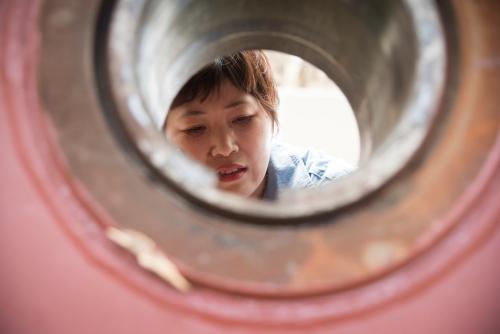It is okay if the painting on the wall is at an angle—it is only a few millimeters, after all. And what does it matter if you buy clothes that are slightly too big? Day to day, hardly anyone notices these little details. We let them slide all the time. It is only on special occasions that the little imperfections become apparent. But in manufacturing, not only is every millimeter and centimeter monitored and measured, even a 1 millimeter error can lead to a cascade of problems. A miss is as good as a mile.
"Good enough is never actually good enough!" Ji Ying exclaims. Ji's name is known throughout the Shanghai Blower Works. This is not just thanks to her great personality and friendly demeanor. Rather it is due to her reputation as a conscientious, detailed, and skilled perfectionist. Her narrow desk is always covered with a pile of drawings, but what surprises people the most is that she has also managed to fit three computers onto the narrow surface. One is used to make drawings, another for simulations, and the third for searching drawings. When it comes to her job, she is, as she puts it, passionate and detail-oriented, working hard to achieve the best she can. Interestingly, Ji's approach to her work corresponds exactly to the modern definition of the "spirit of a craftsman".
The making of a perfectionist
Everyone knows that the devil is in the detail. During the first two years of her career, Ji Ying took this saying to heart. She was in charge of designing axial fans, one of the main products of the Blower Works. Axial fans are mainly used in coal mining.
To gain firsthand technical information and negotiate refurbishment details, Ji and her colleagues had to visit coal mines to take measurements and collect data. Over time, she came to be a breath of fresh air in these male-dominated environments.
From 2003, the factory gradually began to take on more refurbishment projects. With two years of technical experience under her belt, Ji Ying, who was already a core team member, became increasingly busy. It was probably during this time that she developed the habit of arriving to work an hour early. "You can really get into it if you arrive early. It's better for concentrating on checking the drawings." She sometimes even came to work on the weekends to go over her drawings once more. As Ji gained more knowledge and experience, she became more confident.
But in the middle of this period of growth, she experienced a sudden setback. One day, the workshop called to say that two machines were not fitting together as intended. As soon as she got the message, Ji took some colleagues to the workshop to verify the situation. An inspection revealed a problem with the boss hole of the spindle nose. Measurements were taken which showed that the diameter of the hole was one millimeter smaller than it needed to be. Ji had been responsible for this part of the drawing.
"How could I have made such a basic mistake?" Ji chided herself. Luckily, in this case, the problem could be solved by simply re-boring the hole. Even better, it was discovered in the workshop, not on site at the power plant. Otherwise, the losses could have been enormous. Ji speaks frankly about this early experience. "I felt awful at the time, so much so that I was too scared to look at my drawings in case I had made a mistake".
Not long after, her mentor Wu Yuehong learned of the incident. "Don't beat yourself up about it too much. Only two types of designers never make mistakes: designers who don't work, and designers who don't admit to their mistakes," she told her. This little speech lifted Ji's mood and filled her with new hope. "That mistake had a huge impact on me. It's still imprinted on my mind even a decade later. However, it did make me into a true designer." From then on, Ji always designed with more care. She'd carefully double check the data each time, especially when it came to drawings. This is when the perfectionism started.
A detail-oriented character
Ji Ying stands out for her conscientiousness, attention to detail, hard work, and imagination. Gradually, she has become one of the core members of the team in the axial fan section of the Blower Works. "Wu is my second mentor here. She is a very experienced, very strict person. She's meticulous in everything she does. The year I wrote my first ever design plan, she helped me edit it sentence by sentence." Ji Ying still remembers what Wu has said to her. "Your educational background is in machinery and power equipment integration, which suits us well. We'll often go to the workshop to see what's happening there. We need to look at what's happening on the ground to see where we need to improve. If you want to go far, you need to progress faster than other people." With Wu's guidance, Ji understood that she would have to improve her technical knowledge if she wanted to be better at her work. As a result, Ji, who was already a mother, decided to use her free time to go back to school.
"Like the writer Lu Xun said, time is like the water in a sponge—you need to squeeze out every last drop." Ji uses the saying to motivate herself. Since she did not have time during the week, she used the weekends to go to class. If she had to work overtime, she would ask a classmate to record the class and make notes for her. Before an exam, she waited until everyone had gone to bed and then read some books on her own in the living room to make sure she could pass. After five years of hard work, she not only completed all the courses of a university bachelor degree, but also earned the title.
Her hard work did not go unnoticed and she was hired as axial fan team leader. At this time, she also took on an even more important role: from now on, she would calculate and check every single axial fan design project. Sometimes, she would have too many drawings to calculate and check, and would have to take the work home with her. Her mother would exclaim, "Ji Ying, most people make the factory into their home, but you're better than that—you bring the factory into your home!" It was like this that she personally calculated and verified over three hundred axial fan designs over the course of three short years.
With Wu's encouragement, Ji took over Wu's position as the chair of the technology center labor union. When she learned of someone whose family was in the countryside or who was struggling financially, she asked after them and applied for a hardship subsidy on their behalf. She even prepared new year's gifts for young colleagues who were returning home to visit their families over the Chinese New Year. Everyone now fondly calls her "sister". She says from experience, "It's the sentiment that counts. You can retain employees in the factory through emotion as much as through salary and title."
The big little things
At the beginning of 2017, Ji Ying took on the refurbishment of two 660MW unit blowers for the first phase of the state invested Hami Power Plant. However, unlike previous projects, this job was on a very tight schedule and was very technically demanding. The client not only wanted the hydraulic cylinder and the bearing box to be retained, but also required that all static parts be left intact. This was a major challenge in terms of the design.
Ji explained that, first, the blade design was difficult. The blade shape had to meet specific design performance specifications. This meant paying attention to the centrifugal force and recovery force, as well as ensuring that blade fatigue, frequency and safety indicators were up to scratch. Next, to guarantee that the original hydraulic cylinder and bearing box could be used, the blade shaft system needed to be improved. Finally, the wheel cap design had to precisely match the seal used on site, otherwise, the equipment would not be able to be assembled.
Ji did not panic when she was given the project. She calmly investigated each special requirement and went over every detail with the team. If she was not sure of a section, she made multiple different structural designs. Later, she held meetings with processing line staff and finally selected the design that everyone believed was the best.
It is worth noting that while working on the design, Ji also took steps to reduce costs and increase efficiency. For example, the blade shaft driving bearings used Glygole 30 gear lubrication. Ji swapped the imported lubricator for a local one offering the same performance. She also added some innovations to the mechanical design. For example, in the center of the push rod, she added an oil-directing hole at a certain depth which connected with the radial oil outlet hole. After the push rod is installed, 7014 lubricating grease is injected into the air gap between the push rod axle bushes from the oil hole on the hydraulic cylinder side of the push rod. This allows the push rod to provide lubrication when adjusting the rotating blade.
In light of the compact structure, Ji also used BF018 and BF019 to calculate that she should adopt a thin oil lubrication method. This way, the fan would rotate more smoothly, reducing the energy consumption of the blower. To save time, Ji took advantage of the factory's production capabilities and procurement cycle to try to shorten every stage of the design process. Finally, she successfully completed her task by the delivery date. The machinery at the project is still running to this day, and has not broken down. The Hami Power Plant was very satisfied with the work done.
Pay attention to detail, and the big picture will take care of itself
Ji Ying is now at the forefront of new product development. Over the past two years, she has been working on China's first wind tunnel fan at the Blower Works. Previously, Ji had handled the initial structural design for a large number of military projects. When it came to the operating properties of wind tunnel compressors, she and her team had overcome a number of technical challenges.
Although the high-temperature small wind tunnel project was small, nothing could be overlooked. This type of project tests the designer's control of the details. What's more, working on military products is particularly tough. The calculations, decisions and conclusions for each design stage must be checked up to 100 times. Probably only a group like Ji and her team could appreciate this kind of laborious and repetitive task. Ji says it is like untangling a ball of thread. Their job is to gradually straighten out this ball into separate strings, and then weave them together into a delicate yet durable rope. After three months of hard work, the design for the high-temperature small wind tunnel was finished. It was put into production at the end of 2017. At present, the small wind tunnel assembly process is nearing completion.
Today, Ji is considered an expert at the Shanghai Blower Works. Whether there is a product that needs designing or a technical challenge to overcome, she can take charge. For example, when designing a product, she does not only consider technical problems. Rather, she includes the market as an important design variable. She believes that to retain and grow the market share in the increasingly competitive blower market, product technologies not only need to be the best, but also need to take client costs into account. Therefore, she always treats lowering costs as an important element of her design.
Last year, while designing the PAF19.5 product, Ji daringly adjusted the number of blades on the blower based on TLT-Turbo's theory for selecting the right number of blades. This also allowed for bold changes to the hydraulic cylinder model and blade shaft bearings. Just from these two improvements, this blower fan can save approximately 50,000 yuan in costs. Ji explained, "You need to think holistically to lower costs. If you save costs in one area but you increase them in another, or if all other costs increase, you might impact the quality of the product or even the reputation of the entire factory."
Over the past 20 years, Ji's diligence and creative daring have helped her lead over 100 axial fan projects and achieve a number of research outcomes. While she was the leader of the axial fan team, her team won the title of Second National Machinery Industry Advanced Collective. In recent years, Ji has been awarded a variety of honorific titles and prizes, including the Shanghai Electric "Worker with Li Bin Spirit" title, "Outstanding Female Professional" title, the Shanghai science and technology prize, the Shanghai Blower Works Company "Quality Role Model" title, the Shanghai Blower Works Company Outstanding Community Party Member "Innovation Go-Getter" title, the Shanghai Blower Works Company technology cost-cutting contribution award, and the Shanghai Blower Works Company "Advanced Individual" title.
"Life is busy, but rewarding," Ji says. Her insistence on paying attention to details is now a habit that has permeated all areas of her designs. It's also this perfectionist approach that has made the Shanghai Blower Works a byword for quality.









 Shanghai PNS registry No. 31010102007087
Shanghai PNS registry No. 31010102007087